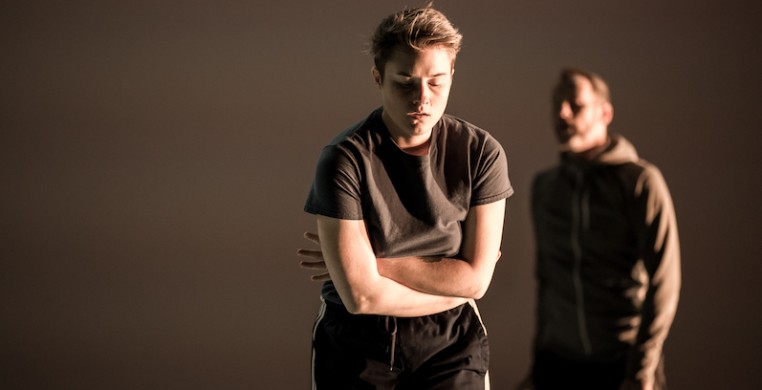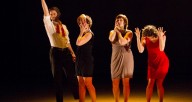UPDATE: The new seechicagodance.com will launch March 31st. Click here to learn more.
Molly Shanahan/MadShak celebrates 25 years with a revised, intimate revival
Molly Shanahan/MadShak marks their 25th Anniversary this year with what they call an "unplugged" version of “Of Whales, Time, and Your Last Attempt to Reach Me,” which premiered last year at the Dance Center of Columbia College Chicago’s Process v. Product Festival. I was in the audience then, and remember feeling electrified afterwards, having just graduated from Columbia and anxious about my own journey as an artist post-undergrad. The freedom with which Shanahan and her cast exhibited in the unknown, in their experimentation, was refreshing, and I carried that feeling with me as I sat in the audience at Dovetail Studios again Friday night.
I remember walking into the studio with my fellow audience members—in total, maybe 40. Among the usual pre-show chatter, there is a whisper coming through the speakers. I notice it in the way that it seems to mix with our voices and stand out with its intonation and reverberation through the space. I wonder if anyone else knows that it’s there, if they notice its nuance and presence. Then she appears. Dressed in a yellow, peplum top and navy-black pants. Her hair is longer than I remember. She smiles with a soft grin to acknowledge the audience’s presence, before settling into her body. The newly-appointed Dr. Molly Shanahan becomes the woman I remember from a year ago, the woman whose movement vocabulary demonstrated a depth of knowledge and expertise, tried and tested.
I am captivated by the freedom in her body when she starts a gestural phrase that spirals out from her feet and is projected out into the space through the slightest movement of her fingers. The voice from earlier carries her, telling a story about what it feels like to forget and the process of having to remember. “I’m walking through this house…and there is this voice that I don’t recognize,” says Shanahan. Then, more bodies appear in the dark—as if soft glimmers from a dream. Shanahan is first joined by dancer Megan Klein; they move across downstage echoing each other’s gestures and phrases inside of the voice’s comforting, Southern drawl.
The intimacy of the space invited the audience into the work for this remount of “Of Whales,” tapping back into its original intentions with fresh energy and adding a new dancer to the original cast of Shanahan, Klein, Kristina Fluty and Jeff Hancock: Michigan native, Maria DiMarzio. I lean into the dancers’ humanity, which is emphasized by their close proximity to the audience. Being so close, I can see their sweat, hear their breath, and even feel the weight of their bodies meeting the sprung, marley floor. From their physicality emerges a compassion for themselves and others in times of anger, rage and frustration to remember.
However, even with the care and compassion that the dancers show one another, and the ways in which they hold space for the audience, I am curious about the ways in which Shanahan uses abstraction as a choreographic tool to create vignettes and scenes that warp reality and fantasy, as it relates to the works’ connection to the dissonance of the 2016 elections.
I feel like I am watching an experiment, a dance with multiple parts and pieces that the dancers must work to piece together in a process that is humorous, laborious and then…silent. The dancers often go from enacting a scene from an ‘80s, Southern-inspired soap opera like “Dallas,” to a unison phrase prioritizing individuality, to a canon of individual solos, and then to stillness where the dancers – still breathing hard, sweat dripping down their faces and hair frazzled – stand outside of the work to witness, watch, gaze at the activities on stage, and sometimes at the audience.
The experimental and dream-like state of the work speaks to its inspirations found in the varying and dissonant memories, responses, and questions that arose both personally and politically throughout the course of the 2016 elections, as Shanahan mentions in her program notes. The fact that the election unearthed overt racism and sexism makes the lack of bodies of color on stage, as well as the physical abstraction, particularly white. As one of the few folks of color in the audience that night, I wondered how the gentleness and care, the witnessing and gazing, the negotiations between one’s “real” and “fake,” could have been complicated by the presence of other bodies of color. How would this shift the way the dancers gazed at each other, the way they look at us, the audience, and the way we look back at them? As the company celebrates its 25th anniversary, “Of Whales” opens up a conversation about the relationship between audience and performer, and I look forward to following more of the experimentation.


